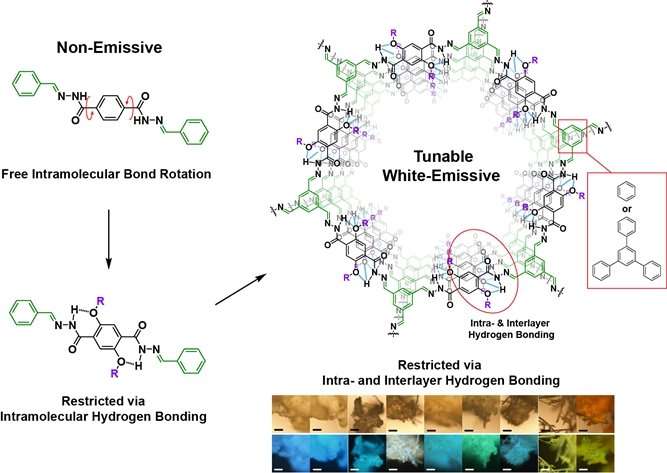Tuneable emissive organic platform

NUS chemists have developed design guidelines for a type of material platform which can activate and adjust the light emission ability of organic molecules for lighting and display applications.
The ability of materials to emit light in the solid state (solid-state fluorescence) is a fundamental property that has many potential applications, such as in lighting and displays. There is an increasing demand for high-performance organic molecules for use in flexible displays and lightings made from organic light emitting diode (OLED) technology. OLED displays are thinner and more flexible compared to conventional liquid crystal displays (LCDs). However, most organic molecules are not able to emit light efficiently in their solid state.
A research team led by Prof Loh Kian Ping from the Department of Chemistry, NUS has developed design guidelines for two dimensional (2-D) covalent organic frameworks (COFs) which can be effectively used to enable and adjust its solid-state fluorescence. COFs are crystalline polymers formed from organic molecular building blocks which are strongly linked by covalent bonds. These organic molecular building blocks are usually non-emissive. The research team has demonstrated that the light emission colour from the COF can be made to change from blue to green to yellow. Even emission of white light is possible. Compared to fluorescent small organic molecules, this type of material platform can provide greater light emission and a wider colour range and can potentially be applied in sensing, lighting and display applications.
The photoluminescence of layered organic materials is usually quenched. This is due to the π-π stacking or bond rotation that causes non-emissive dissipation of photoexcitation energy. This type of COF platform overcomes the problem by restricting the intramolecular bond rotation via intra- and interlayer hydrogen bonding among the stacked COF layers.
Mr Li Xing, a Ph.D. student working on this project, said, "The COF platform provides flexibility in the structural design and modification of the material. By adjusting the sidechain functionality and linker for the COF platform, the light emitting properties of the material can be altered to suit different applications."
"Highly emissive molecular units can be incorporated into this system to further enhance the emission efficiency," added Prof Loh.
More information: Xing Li et al. Tuneable near white-emissive two-dimensional covalent organic frameworks, Nature Communications (2018). DOI: 10.1038/s41467-018-04769-6
Journal information: Nature Communications
Provided by National University of Singapore





















